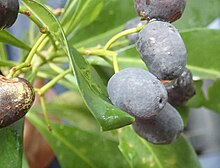| Kerosenewood | |
|---|---|

| |
| In Royal Botanic Gardens Victoria | |

| |
| Fruit at Cooloola, Queensland | |
| Scientific classification | |
| Kingdom: | Plantae |
| Clade: | Tracheophytes |
| Clade: | Angiosperms |
| Clade: | Eudicots |
| Clade: | Rosids |
| Order: | Sapindales |
| Family: | Rutaceae |
| Subfamily: | Zanthoxyloideae |
| Genus: | Halfordia F.Muell. |
| Species: | H. kendack |
| Binomial name | |
| Halfordia kendack (Montrouz.) Guillaumin | |
| Synonyms | |
| |
Halfordia is a genus of plants in the family Rutaceae containing the single species Halfordia kendack commonly known as kerosenewood, southern ghittoe or saffronheart, is a rainforest plant that is native to eastern Australia, New Guinea and New Caledonia. It is a shrub or tree with elliptical to egg-shaped leaves with the narrower end towards the base, panicles of white, greenish white or yellowish flowers and purple to bluish black, spherical to oval fruit.
Description
Halfordia kendack is a shrub or tree that typically grows to a height of 25–30 m (82–98 ft), the trunk with a diameter of 75 cm (30 in) and often flanged at the base. It has grey or pale yellowish-brown bark with corky pustules and is often rough and wrinkled. The smaller branches are smooth, green and about 13 mm (0.51 in) thick. The leaves are arranged in opposite pairs, elliptical to egg-shaped or lance-shaped with the narrower end towards the base, 50–180 mm (2.0–7.1 in) long and 10–50 mm (0.39–1.97 in) wide and more or less sessile or on a petiole up to 20 mm (0.79 in) long. The leaf tapers to the base and has a rounded or tapered tip and new leaves have a noticeable aromatic scent resembling eau de cologne. There are many conspicuous, closely spaced oil dots.
The flowers are arranged in panicles 30–80 mm (1.2–3.1 in) long, each flower about 11 mm (0.43 in) in diameter on a pedicel 2–3 mm (0.079–0.118 in) long. The sepals are 0.5–1 mm (0.020–0.039 in) long and the petals white, greenish white or yellowish and 4–6 mm (0.16–0.24 in) long with short, soft hairs pressed against the back. Flowering occurs from January to May and the fruit is a purple to bluish black, spherical to oval drupe 8–12 mm (0.31–0.47 in) long that is present in most months.
Taxonomy
The genus Halfordia was first formally described in 1865 by Ferdinand von Mueller in Fragmenta phytographiae Australiae and the first species he described was Halfordia drupifera, now considered a nomen illegitimum.
In 1860, Xavier Montrouzier described Eriostemon kendack in Mémoires de l'Académie Royale des Sciences, Belles-Lettres et Arts de Lyon, and in 1911, André Guillaumin changed the name to Halfordia kendack in Notulae Systematicae.
Halfordia is named after George Britton Halford and "kendack" is an indigenous name for this tree in New Caledonia.
Distribution and habitat
Kerosenewood grows in monsoon woodland and rainforest in coastal and inland areas from sea level to an altitude of 1,260 m (4,130 ft). It is found in New Caledonia, New Guinea and eastern Australia. In Australia it occurs from the Torres Strait Islands to the Cape York Peninsula in Queensland, south to Iluka in New South Wales, including on the Mcpherson and Tweed Ranges.
Ecology
The hard seed is surrounded by pulp, which is eaten by a variety of birds, such as the green catbird, topknot pigeon and wompoo fruit dove. Germination from seeds can be difficult, often erratic.
Uses
Before the development of fibreglass and carbon fibre, the timber of this species was used in the manufacture of fishing rods. The oily, flexible timber is hard, weighing 1100 kg per cubic metre. This plant is gaining popularity in horticulture. The wood is highly flammable, and chips of wood may be used to start a fire, even when wet, hence one of the common names, "kerosene wood".
References
- ^ "Halfordia kendack". Australian Plant Census. Retrieved 23 July 2020.
- "Halfordia". Australian Plant Census. Retrieved 23 July 2020.
- ^ F.A.Zich; B.P.M.Hyland; T.Whiffen; R.A.Kerrigan (2020). "Halfordia kendack". Australian Tropical Rainforest Plants Edition 8 (RFK8). Centre for Australian National Biodiversity Research (CANBR), Australian Government. Retrieved 25 June 2021.
- ^ Floyd, A.G. (2008). Rainforest Trees of Mainland South-eastern Australia (2nd ed.). Inkata Press. p. 363. ISBN 978-0-9589436-7-3.
- ^ Hartley, Thomas G.; Wilson, Annette J.G. (ed.) (2013). Flora of Australia (Volume 26). Canberra: Australian Biological Resources Study. pp. 83–84. Retrieved 23 July 2020.
{{cite book}}:|first2=has generic name (help) - ^ Richards, P.G. "Halfordia kendack". Royal Botanic Garden Sydney. Retrieved 23 July 2020.
- "Halfordia". APNI. Retrieved 23 July 2020.
- von Mueller, Ferdinand (1865). Fragmenta phytographiae Australiae. Vol. 5. Melbourne: Victorian Government Printer. p. 43. Retrieved 23 July 2020.
- "Eriostemon kendack". APNI. Retrieved 23 July 2020.
- Montrouzier, Xavier (1860). "Flore de L'Ile Art". Mémoires de l'Académie Royale des Sciences, Belles-Lettres et Arts de Lyon. 10: 191–192. Retrieved 23 July 2020.
- "Halfordia kendack". APNI. Retrieved 23 July 2020.
- Guillaumin, André (1911). "Flore générale de L'Indo-Chine". Notulae Systematicae (Paris). 2: 98. Retrieved 23 July 2020.
- "A Mystery Tree Bears Fruit". Australian Native Plants Society (Australia). Retrieved 23 July 2020.
- Conn, Barry; Damas, Kipiro. "Halfordia kendack (Montrouz.) Guillaumin". PNG Trees. Retrieved 23 July 2020.
- "Halfordia kendack (Montrouz.) Guillaumin". Endemia New Caledonia. Retrieved 23 July 2020.